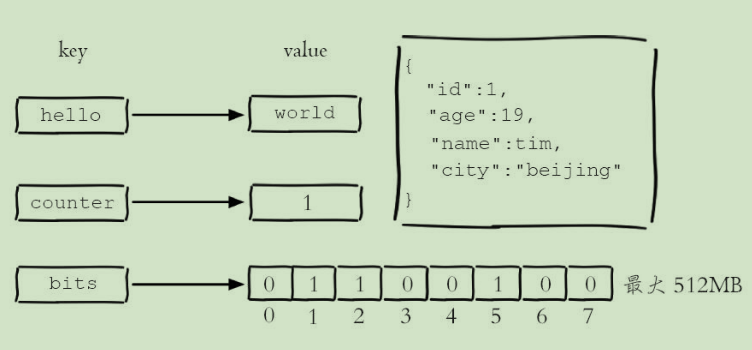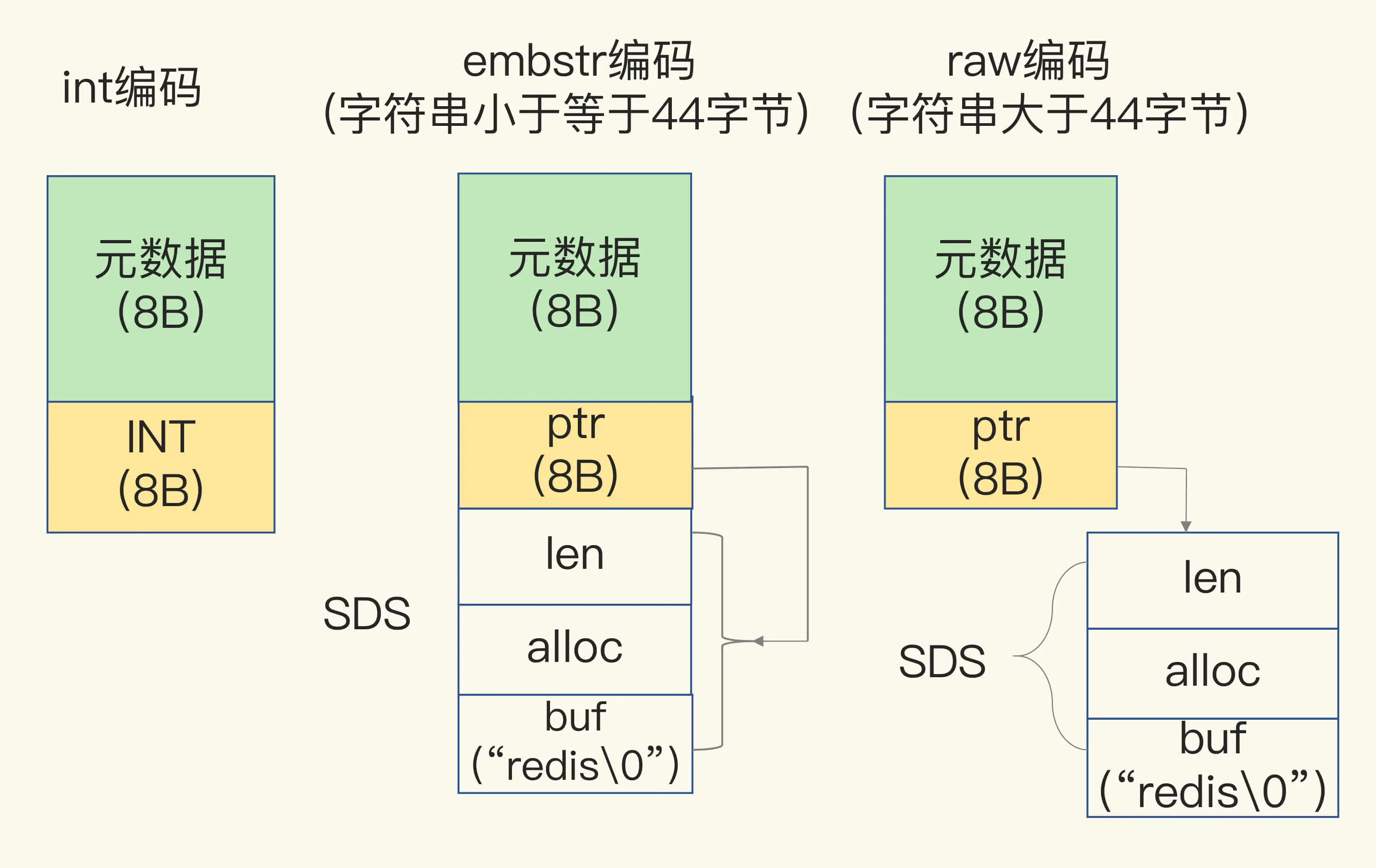数据结构
二进制安全:底层没有类型概念,只有byte数组,所以客户端需要将数据序列化成字节数组
string
- 字符串、数值、bit位图


应用场景:
- 做简单的KV缓存
sequenceDiagram participant User as 用户 participant WebServer as Web服务器 participant Redis as 缓存层 (Redis) participant MySQL as 持久层 (MySQL) User->>WebServer: 请求数据 WebServer->>Redis: 查询缓存 alt hit Redis-->>WebServer: return 缓存数据 else miss Redis->>MySQL: 查询数据库 MySQL-->>Redis: 数据结果 Redis->>Redis: write cache Redis-->>WebServer: 缓存数据 end WebServer-->>User: return 数据响应设计合理的键名,有利于防止键冲突和项目的可维护性,比较推荐的方式是使用业务名:对象名:id:[属性]作为键名
- incr(计数):抢购,秒杀,详情页,点赞,评论
- session服务器
stateDiagram-v2 client --> WebServer1 RedisSession --> WebServer1 WebServer1 --> RedisSession WebServer2 --> RedisSession RedisSession --> WebServer2 WebServer3 --> RedisSession RedisSession --> WebServer3- 限速 通过对key设置过期时间的方式限制用户请求频率
- 使用位图来处理海量数据
- 哈希类型 hash
- 做对象属性读写
- 列表类型 list
- 可以做消息队列或者可以来存储列表信息,进行分页查询
- 集合类型 set
- 自动去重
- 推荐系统:数据交集
- 有序集合类型 sortedset
- 排序
GEO
地理信息定位功能
geoadd locations 116.38 39.55 beijing # 添加成员geopos locations beijing # 获取geodist locations beijing tianjin [m|km|mi|ft] # 计算两地距离georadiusbymember locations beijing 150 km # 获取北京方圆150km内的成员geohash locations beijing # 将二维经纬度转换为一维字符串关于geohash:
- 字符串越长,表示的位置更精确
- 两个字符串越相似,它们之间的距离越近,Redis利用字符串前缀匹配算法实现相关的命令
- Redis正是使用有序集合并结合geohash的特性实现了GEO的若干命令
发布订阅
新开启的订阅客户端,无法收到该频道之前的消息
pubsub channels # 查看活跃的频道(至少一个订阅者)pubsub numsub chat # 查看频道订阅数pubsub numpat # 查看模式订阅数- 消费者
SUBSCRIBE redisChat # 订阅unsubscribe redisChat # 取消订阅psubscribe pattern # 按照给定模式订阅punsubscribe pattern # 按照给定模式取消订阅- 生产者向频道发送数据
PUBLISH redisChat "Redis is a great caching technique"pub/sub 是通过一个 key 为频道名称,value 为客户端列表的哈希表、客户端所订阅的频道模式哈希表来实现的
server.pubsub_channels = dictCreate(&keylistDictType);server.pubsub_patterns = dictCreate(&keylistDictType);server.pubsubshard_channels = dictCreate(&keylistDictType);在发送消息时,通过频道名称找到所有客户端,或者判断客户端所订阅的频道模式是否匹配发消息的频道,找到对应的客户端,挨个发消息
while((de = dictNext(di)) != NULL) { robj *pattern = dictGetKey(de); list *clients = dictGetVal(de); if (!stringmatchlen((char*)pattern->ptr, sdslen(pattern->ptr), (char*)channel->ptr, sdslen(channel->ptr),0)) continue; listRewind(clients,&li); while ((ln = listNext(&li)) != NULL) { client *c = listNodeValue(ln); addReplyPubsubPatMessage(c,pattern,channel,message); updateClientMemUsageAndBucket(c); receivers++; }}而客户端订阅频道,则就是对上述的哈希表做添加操作
if (dictAdd(type.clientPubSubChannels(c),channel,NULL) == DICT_OK) { retval = 1; incrRefCount(channel); /* Add the client to the channel -> list of clients hash table */ de = dictFind(*type.serverPubSubChannels, channel); if (de == NULL) { clients = listCreate(); dictAdd(*type.serverPubSubChannels, channel, clients); incrRefCount(channel); } else { clients = dictGetVal(de); } listAddNodeTail(clients,c);}/* Notify the client */addReplyPubsubSubscribed(c,channel,type);内部数据结构
Redis 为了尽量节省内存,不仅在数据结构的设计上下足了功夫,同时也运用了享元设计模式来提升内存效率
stateDiagram-v2 String --> 简单动态字符串(SDS) List --> 双向链表 List --> 压缩链表 Hash --> 压缩列表 Hash --> 哈希表 SortedSet --> 压缩链表 SortedSet --> 跳表 Set --> 哈希表 Set --> 整数数组| 名称 | 查找时间复杂度 |
|---|---|
| 哈希表 | 0(1) |
| 跳表 | O(logN) |
| 双向链表 | O(N) |
| 压缩列表 | O(N) |
| 整数数组 | O(N) |
redisObject
Redis存储的所有值对象在内部定义为redisObject结构体
struct { type // 表示当前对象使用的数据类型 encoding // 代表当前对象内部采用哪种数据结构实现 lru // 记录对象最后一次被访问的时间 refcount // 记录当前对象被引用的次数 Redis可以使用共享对象的方式来节省内存 *ptr // 如果是整数,直接存储数据;否则表示指向数据的指针 如果对象是字符串且长度<=44字节的会直接存储在这 避免间接内存操作}SDS
和 C 语言中的字符串操作相比,SDS 通过记录字符数组的使用长度和分配空间大小,避免了对字符串的遍历操作,降低了操作开销
同时 SDS 设计了针对不同长度字符串的结构头,是为了能灵活保存不同大小的字符串,从而有效节省内存空间
// __attribute__ ((__packed__)) 告诉编译器取消结构体内存对齐,可以减少内存消耗,但可能会导致访问结构体成员时效率降低struct __attribute__ ((__packed__)) sdshdr16 { uint16_t len; /* used */ uint16_t alloc; /* excluding the header and null terminator */ unsigned char flags; /* 3 lsb of type, 5 unused bits */ char buf[];};struct __attribute__ ((__packed__)) sdshdr32 { uint32_t len; /* used */ uint32_t alloc; /* excluding the header and null terminator */ unsigned char flags; /* 3 lsb of type, 5 unused bits */ char buf[];};对于长度不超过 44 字节的字符串,Redis 先申请一块连续的内存空间,把 redisObject 结构体和 SDS 结构体紧凑地放置在一起,避免内存碎片和两次内存分配的开销
robj *createEmbeddedStringObject(const char *ptr, size_t len) { robj *o = zmalloc(sizeof(robj)+sizeof(struct sdshdr8)+len+1); struct sdshdr8 *sh = (void*)(o+1); ... o->ptr = sh+1; ... //... 初始化字符串空间 return o;}字典
redis 使用了链表来应对哈希冲突
typedef struct dictIterator { dict *ht; int index; dictEntry *entry, *nextEntry;} dictIterator;typedef struct dict { dictEntry **table; dictType *type; unsigned long size; unsigned long sizemask; unsigned long used; void *privdata;} dict;struct dictEntry { void *key; union { void *val; uint64_t u64; int64_t s64; double d; } v; struct dictEntry *next; /* Next entry in the same hash bucket. */};redis使用了两张哈希表来方便扩容时的rehash操作
当满足以下条件,就会进行rehash
- 刚开始时哈希表长度为0
- 哈希表中的元素数量 / 哈希表长度 > dict_force_resize_ratio(负载因子)
在进行rehash时,为避免给服务器带来过大负担,并不是一次性将所有值rehash到另外一张表,而是通过渐进的方式,每次对字典执行添加、删除、查找或者更新操作时,将哈希表 entry 的转移操作分散在后续的每一次请求中以及定时任务中,而非一次性执行完。每迁移一个 key,结构体 dict 的 used就会 - 1,当这个used为0时,就代表迁移完了
此时新增的 key 都会写到目标ht中,而删改则会先对迁移源表找,没有的话再在新ht中找
压缩列表
数组中的每一个元素都对应保存一个数据。和数组不同的是,压缩列表在表头有三个字段 zlbytes、zltail 和 zllen,分别表示列表长度、列表尾的偏移量和列表中的 entry 个数;压缩列表在表尾还有一个 zlend,表示列表结束
针对不同长度的数据,使用不同大小的元数据信息(prevlen 和 encoding)来描述每一个位置的数据,从而提升内存效率
如果我们要查找定位第一个元素和最后一个元素,可以通过表头三个字段的长度直接定位
虽然 ziplist 节省了内存开销,可它也存在两个设计代价:一是不能保存过多的元素,否则访问性能会降低;二是不能保存过大的元素,否则当一个元素插入后,会引起当前位置元素新增 prevlensize 的空间。而当前位置元素的空间增加后,又会进一步引起该元素的后续元素,其 prevlensize 所需空间的增加
SortedSet
Sorted Set 能支持范围查询,这是因为它的核心数据结构设计采用了跳表,而它又能以常数复杂度获取元素权重,这是因为它同时采用了哈希表进行索引
typedef struct zset { dict *dict; zskiplist *zsl;} zset;quicklist
一个 quicklist 就是一个链表,而链表中的每个元素又是一个 ziplist。quicklist 通过控制每个 quicklistNode 中,ziplist 的大小或是元素个数,就有效减少了在 ziplist 中新增或修改元素后,发生连锁更新的情况
typedef struct quicklist { quicklistNode *head; quicklistNode *tail; unsigned long count; /* total count of all entries in all listpacks */ unsigned long len; /* number of quicklistNodes */ signed int fill : QL_FILL_BITS; /* fill factor for individual nodes */ unsigned int compress : QL_COMP_BITS; /* depth of end nodes not to compress;0=off */ unsigned int bookmark_count: QL_BM_BITS; quicklistBookmark bookmarks[];} quicklist;typedef struct quicklistNode { struct quicklistNode *prev; struct quicklistNode *next; unsigned char *entry; size_t sz; /* entry size in bytes */ unsigned int count : 16; /* count of items in listpack */ unsigned int encoding : 2; /* RAW==1 or LZF==2 */ unsigned int container : 2; /* PLAIN==1 or PACKED==2 */ unsigned int recompress : 1; /* was this node previous compressed? */ unsigned int attempted_compress : 1; /* node can't compress; too small */ unsigned int dont_compress : 1; /* prevent compression of entry that will be used later */ unsigned int extra : 9; /* more bits to steal for future usage */} quicklistNode;listpack
紧凑列表,它的特点就是用一块连续的内存空间来紧凑地保存数据,同时为了节省内存空间,listpack 列表项使用了多种编码方式,来表示不同长度的数据,这些数据包括整数和字符串
listpack 中每个列表项不再包含前一项的长度了,因此当某个列表项中的数据发生变化,导致列表项长度变化时,其他列表项的长度是不会受影响的
rax
一种前缀树的变体,如果一系列单字符节点之间的分支连接是唯一的,那么这些单字符节点就可以合并成一个节点,而这种结构的树,就正是 Radix Tree,也被称为基数树
stateDiagram-v2 g --> o o --> l l --> d o --> s s --> estateDiagram-v2 go --> ld go --> se操作复杂度
- 集合类型对单个数据实现的增删改查操作,复杂度由集合采用的数据结构决定,如 Hash 的增加查找都是O(1)
- 集合类型中的遍历操作,返回集合中的所有数据,这类操作的复杂度一般是 O(N)
- 集合类型对集合中所有元素个数的记录,复杂度为 O(1),因为这些结构中专门记录了元素的个数统计
- 还有一些特殊情况,压缩列表和双向链表都会记录表头和表尾的偏移量,所以POP PUSH 操作也为 O(1)